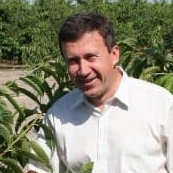The Impact of Environmental Factors on the Quality of Horticultural Commodities
A special issue of Agriculture (ISSN 2077-0472). This special issue belongs to the section "Agricultural Product Quality and Safety".
Deadline for manuscript submissions: 30 September 2024 | Viewed by 576
Special Issue Editor
Interests: fruit production; fruit storage; engineering horticulture; bioactive compounds; processing; polyphenols; postharvest quality; edible flowers; anthocyanins; frost resistance; harvest date prediction; active temperatures; fruit quality; color development; orchard replantation; fertilization
Special Issues, Collections and Topics in MDPI journals
Special Issue Information
Dear Colleagues,
Horticultural production is placing an increasing emphasis on sustainable development and the biological balance of ecosystems. Without losing sight of this overarching goal, actions are taken to ensure that crops are characterized by parameters that define high quality. Therefore, new environmentally friendly production systems are being developed, in which the growing methods and techniques are strongly based on environmental conditions. This involves breeding new cultivars with improved resistance to adverse factors, using crop rotation to limit exposure to pathogens in soil, organic mulching, stimulating biological processes in the rhizosphere, and applying biological preparations for plant protection and nutrition to improve product quality.
Just like other food products, horticultural products offered to consumers should be of good quality and, above all, safe to eat. Each step from the field to the table must be subject to procedures that ensure that relevant quality requirements are met. Fruit, vegetables, edible flowers and other horticultural commodities must fulfil the highest quality standards, which, according to the literature, fall into three areas: sensory quality, health-promoting properties and their availability, and the increasingly important symbolic quality.
Consumer choices are dictated by the appearance, taste, nutritional attributes, safety and often environmental considerations regarding production.
Aside from the growing method, pruning, pollination, protection and fertilization, product quality is affected by environmental conditions, the most notable of which include all macro- and microclimatic elements and soil environment. Among these conditions is air temperature, which affects physiological processes by slowing them down when above 35 °C and causes physiological disorders or damage to plants when below 0 °C. Similarly important are precipitation, sun radiation and wind conditions. These factors play a significant role in shaping the quality of fruit intended for fresh consumption, processing or therapeutic purposes as a source of bioactive compounds during the growth period.
Prof. Dr. Grzegorz Lysiak
Guest Editor
Manuscript Submission Information
Manuscripts should be submitted online at www.mdpi.com by registering and logging in to this website. Once you are registered, click here to go to the submission form. Manuscripts can be submitted until the deadline. All submissions that pass pre-check are peer-reviewed. Accepted papers will be published continuously in the journal (as soon as accepted) and will be listed together on the special issue website. Research articles, review articles as well as short communications are invited. For planned papers, a title and short abstract (about 100 words) can be sent to the Editorial Office for announcement on this website.
Submitted manuscripts should not have been published previously, nor be under consideration for publication elsewhere (except conference proceedings papers). All manuscripts are thoroughly refereed through a single-blind peer-review process. A guide for authors and other relevant information for submission of manuscripts is available on the Instructions for Authors page. Agriculture is an international peer-reviewed open access monthly journal published by MDPI.
Please visit the Instructions for Authors page before submitting a manuscript. The Article Processing Charge (APC) for publication in this open access journal is 2600 CHF (Swiss Francs). Submitted papers should be well formatted and use good English. Authors may use MDPI's English editing service prior to publication or during author revisions.
Keywords
- biotic and abiotic stress
- climate change
- total soluble solids
- internal quality
- nutrition
- bioactive compounds
- production systems
- fruit and vegetable production systems





